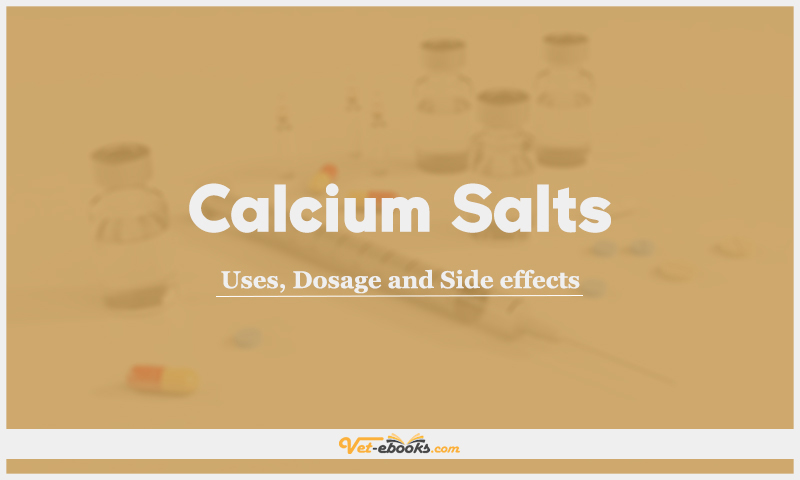Calcium Salts: Uses, Dosage and Side Effects
Overview
- Calcium is an essential element involved in the maintenance of numerous homeostatic roles and key reactions including activation of enzymes, cell membrane potentials, and nerve and musculoskeletal function. Calcium salts includes :
- Calcium borogluconate.
- Calcium carbonate.
- Calcium chloride.
- Calcium gluconate.
- Calcium lactate.
Uses of Calcium salts
- Management of hypocalcemia.
- Management of hyperkalaemic cardiotoxicity associated with urinary obstruction.
Dose of Calcium salts in Dogs and Cats
Dogs:
• Parenteral treatment of hypocalcemia or hyperkalaemic cardiotoxicity:
50–150 mg/kg calcium (boro)gluconate (which is equivalent to 3.8–11.4 mEq/kg of elemental calcium when boro gluconate is used or 4.5–14 mg/kg of elemental calcium when gluconate is used).
Alternatively, 5–10 mg/kg calcium chloride or 0.05–0.1 ml/kg of a 10% solution i.v. (equivalent to 0.068–0.136 mEq/kg). Additional doses to a maximum of 1–1.5 g/kg calcium boro(gluconate) may need to be administered i.v. over the next 24 hours. Adjust the dose by monitoring serum calcium and phosphorus levels.
• Oral treatment of hypocalcemia:
5–22 mg of elemental calcium/kg p.o. q8h; adjust dose by monitoring serum calcium and phosphorus levels.
Cats:
• Parenteral treatment of hypocalcemia:
95–140 mg calcium gluconate/kg slowly i.v. to effect. Using 10% calcium gluconate this is equivalent to 1–1.5 ml/kg slowly i.v. over 10–20 min. Monitor ECG if possible. If bradycardia or Q–T interval shortening occurs, slow rate or temporarily discontinue. Once life-threatening signs are resolved, add calcium gluconate to i.v. fluids and administer slowly at 60–90 mg/kg/day elemental calcium. This converts to 2.5 ml/kg of 10% calcium gluconate q6–8h or the equivalent as a constant rate infusion over 24 hours. Monitor serum calcium and adjust as needed.
• Oral treatment of hypocalcemia:
Begin oral therapy at 10–25 mg elemental calcium/kg q6–8h; adjust dose by monitoring serum calcium and phosphorus levels.
Drug Dosage Calculator
You Should Give:
Side Effects of Calcium salts in Dogs and Cats
- Hypercalcaemia can occur, especially in renal impairment or cardiac disease.
- Tissue irritation is common and can occur with injectable preparation regardless of route.
- The rapid injection may cause hypotension, cardiac arrhythmias and cardiac arrest.
- Perivascular administration is treated by stopping the infusion, infiltrating the tissue with normal saline and topical application of corticosteroids.
- Note that some chewable formulations of calcium (e.g. Calcichew) may contain xylitol and overdosage could produce hypoglycemia.
Contraindications of Calcium salts in Dogs and Cats
- Ventricular fibrillation or hypercalcemia.
- Calcium should be avoided in pregnancy unless there is a deficient state.
- Hyperkalaemia associated with hypoadrenocorticism is often associated with hypercalcemia and therefore additional calcium is not recommended in those cases.
Some Notes:
- Calcium gluconate and borogluconate are preferred. .
- Serum calcium levels and renal function tests should be assessed before starting therapy.
- ECG monitoring during i.v. infusions is advised.
- Avoid using mixed electrolyte solutions intended for cattle use if possible.
- Treatment of hyperkalaemic cardiotoxicity with calcium rapidly corrects arrhythmias but effects are short-lived (5–10 min to effect) and i.v. glucose 0.5–1 g/kg ± insulin may be needed to decrease serum potassium.
- Parenteral calcium should be used very cautiously in patients receiving digitalis glycosides or those with cardiac or renal disease.
- Patients on digitalis glycosides are more prone to develop arrhythmias if given i.v. calcium.
- All calcium salts may antagonize verapamil and other calcium-channel blockers.
- Calcium boro gluconate is compatible with most i.v. fluids except those containing other divalent cations or phosphorus.
- Calcium borogluconate is reportedly compatible with lidocaine, adrenaline and hydrocortisone.
- Calcium chloride is incompatible with amphotericin B, cefalotin sodium and chlorphenamine.
- Calcium gluconate is incompatible with many drugs, including lipid emulsions, propofol, amphotericin B, cefamandole, naftate, cefalotin sodium, dobutamine, methylprednisolone sodium succinate and metoclopramide.
Do You Want To Increase Your Veterinary Knowledge and Practical Skills?
You Can Now Browse and Download +3000 Books For Veterinary Professionals & Students Online.
Download Veterinary Books





















